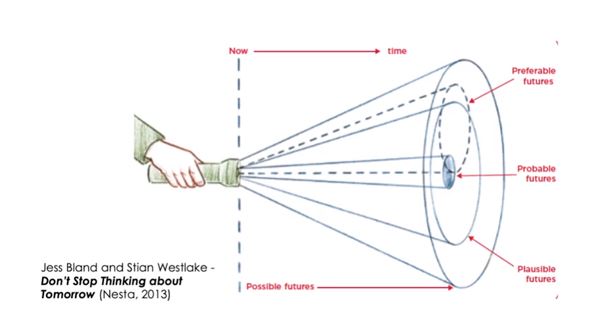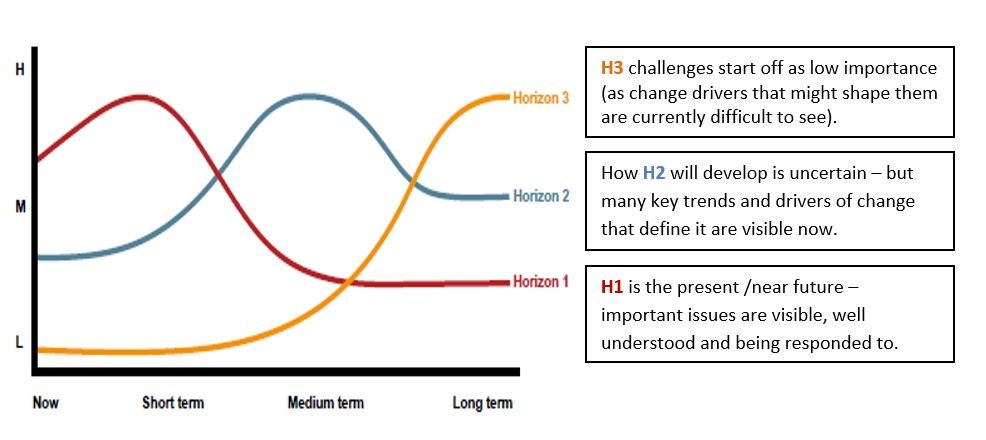Helen Beers from HSE’s Foresight Centre discusses the topic of time – past, present and future – and considers why this is important for health and safety.
It goes without saying that everyone should make time for health and safety. However, thinking about ‘time’ from different perspectives can improve our understanding about health and safety behaviours, and enable us to anticipate and keep pace with changes in the world of work.
So how might ‘time’ help explain behaviour?
 Before joining HSE, I carried out some research interviewing adults at risk of heart disease. Some of these people actively sought to take personal responsibility for improving their health, whilst others chose to avoid thinking about it. I found that ‘time’ was a recurring theme in the way interviewees talked about their health and was a factor that influenced their health behaviour.
Before joining HSE, I carried out some research interviewing adults at risk of heart disease. Some of these people actively sought to take personal responsibility for improving their health, whilst others chose to avoid thinking about it. I found that ‘time’ was a recurring theme in the way interviewees talked about their health and was a factor that influenced their health behaviour.
We are all predisposed to be oriented towards a combination of past, present and future time perspectives – and this influences our behaviour. For example, in my research I found that those who had a balanced time perspective were most likely to engage in physical activity behaviour. These were people who focused predominantly on the future and had a longer term view (future time perspective). They felt positive about both the future and the past, and believed they had some personal control over the present solution to their health problem.
But what do we actually mean when we talk about time in the context of how we behave? Time can be conceptualised in different ways: it is a broad and complex concept. Those with a psychology background might describe time perspective as the often non-conscious and subjective manner in which each of us processes information relating to time – the way we divide time in to the past, present and future. Our time perspective concerns how future outcomes influence our current behaviours, and it can provide a structure for how we select and pursue short-term or long-term goals.
It is also useful to look at time from another perspective, where time orientation is considered in terms of ‘discounting’. This is the relative value that people place on outcomes, or rewards they expect to gain from something, at different points in time. It involves comparing the value of something at an earlier date, with the value at a later date. People have a tendency to give more weight to rewards gained at the present time over those that might be gained in the future. It is this preference for outcomes across time that can explain why some individuals make decisions that might seem unwise and impulsive to others.
Some have suggested that people’s perception of time is integral to our motivation, influencing our behaviour and playing a key role in which goals we select and pursue. If we perceive time as expansive and open-ended, then our focus will be on long-term goals. However, if we perceive it to be limited, activities that are unpleasant or devoid of meaning will be avoided. A preference for a larger and later reward, over a smaller immediate reward, will decline as the larger and later reward becomes further removed in time: as rewards can cease to be valuable if they are very distant in time.
Many health promoting behaviours require us to endure minor inconvenience and/or discomfort in the short-term in order to obtain favourable outcomes that we might realise at some unknown time in the distant future. Anticipated long-term outcomes are likely to be overshadowed by anticipated immediate outcomes. For example, this might partly explain why people do not wear personal protective equipment – if they focus on the immediate inconvenience and discomfort.
A foresight perspective
Our foresight work at HSE considers possible or probable futures (Figure 1), and we use horizon scanning to inform our thinking about this – please two previous SHP articles, for more details on our work:
The future of health and safety
Horizon Scanning: making sense of the future
Our goal is not to predict the future, but to provide knowledge that can help appropriate action to be taken today, in order to address future potential health and safety issues.
Figure 1. Don’t stop thinking about tomorrow.
In HSE’s Foresight Centre, we do consider what has gone before (the past). Whilst we also monitor what is currently happening (the present), our focus is on the mid to long term (the future). These three time frames are referred to as the ‘three horizons’, and they provide us with a broad framework for considering the potential importance of health and safety challenges. Figure 2 shows how a challenge might shift in terms of its visibility and importance (low (L), medium (M) or high (H)) over time.
Figure 2. The three horizons model – Government Office for Science: The Futures Toolkit. HSE will already be responding to Horizon 1 (H1) issues. These are issues that are currently visible and well understood. Over time these may be assimilated into policy or strategy or overtaken by other trends or events that are less important now but will become more important in the medium term.
HSE will already be responding to Horizon 1 (H1) issues. These are issues that are currently visible and well understood. Over time these may be assimilated into policy or strategy or overtaken by other trends or events that are less important now but will become more important in the medium term.
The task for regulators, policy makers and strategists is to look at issues in Horizon 2 (H2) – to explore possible outcomes and to adapt policy and strategy to anticipate future need. In the longer term, H2 will give way to Horizon 3 (H3) and a new set of policy and strategy challenges will emerge that require a policy response. One of our tasks is to track the drivers of change, such as developments in artificial intelligence and the ageing workforce (Changing worlds of work and occupational health: Insights on working into older age and Working beyond 65: the health and safety impact) that will shape (H3), so that potential strategic challenges and the policy or strategy response can be explored.
Are our perceptions of time changing? And what might this mean for health and safety?
HSE’s work on the gig economy found evidence to indicate an increase in work intensification for some workers, including long hours, highly demanding tasks, low job control and little or no support. It is possible that these workers may be put in potentially risky situations in order to meet targets and make sufficient income. Similarly, our work in the transport sector found evidence to indicate that some professional drivers are also being put under increasing time pressures. This may, in part, be driven by the increase in on-line retail, a 24/7 always-on work environment and shift in consumer behaviour that expects same or next day delivery of on-line orders. We also found evidence to suggest that some drivers have insufficient time for recovery between work periods, and this has a negative impact on the amount of sleep they have; which in turn can negatively influence their health as well as having potential safety implications. Others have suggested that a majority of us are now sleep deprived during the working week, as the timing of sleep has changed during industrialisation. The implications of this may be far-ranging in terms of potential influence on not just quality of life but on learning, memory, vigilance and performance.
We know that more people are now in insecure and precarious work, and there is some evidence that this can result in exhaustion and mental health issues for some workers. The evidence also indicates that workers are concerned about loss of control over their time; they struggle with multiple jobs to make ends meet and have little time to spend with family.
In the workplace of the future, is it more likely that greater numbers of workers will perceive their time as limited? Will short-term goals predominate? If workers are increasingly put under greater time pressures to what extent will this influence their health and safety behaviours? Which groups of workers might be most affected or at risk?
We do know that people can be bad at anticipating the future. For example, in 1943 IBM’s Chairman Thomas Watson, is reported to have believed that “there is a world market for about five computers”. Even Einstein was bad at anticipating the future: he did not foresee that nuclear energy “would be released in his lifetime”, believing that it was only “theoretically possible”. In fact, this became practical through “the discovery of chain reaction”.
Whilst the future cannot be predicted, HSE will continue to anticipate change. We are committed to ensuring that HSE has the right evidence for the future – and our foresight work will continue to inform our science and evidence delivery plans. We produce foresight reports and our latest one, which considers the human impact of the changing nature of work over the next four to ten years, will be published shortly. I look forward to sharing an overview of this report with SHP readers.
Author: Helen Beers
The opinions and/or conclusions expressed in this article, are those of the author alone and do not necessarily reflect HSE policy.
©Crown Copyright 2020, Health and Safety Executive
Helen Beers, PhD, is Technical Team Lead for HSE’s Foresight Centre and leads HSE’s priority science on demographics. She has a social science and health psychology research background. Helen’s main area of research interest is demographic change, with a particular focus on the potential health and safety implications of the changing world of work and the ageing workforce.
The Safety Conversation Podcast: Listen now!
The Safety Conversation with SHP (previously the Safety and Health Podcast) aims to bring you the latest news, insights and legislation updates in the form of interviews, discussions and panel debates from leading figures within the profession.
Find us on Apple Podcasts, Spotify and Google Podcasts, subscribe and join the conversation today!

 Before joining
Before joining 
 HSE will already be responding to Horizon 1 (H1) issues. These are issues that are currently visible and well understood. Over time these may be assimilated into policy or strategy or overtaken by other trends or events that are less important now but will become more important in the medium term.
HSE will already be responding to Horizon 1 (H1) issues. These are issues that are currently visible and well understood. Over time these may be assimilated into policy or strategy or overtaken by other trends or events that are less important now but will become more important in the medium term.
A very interesting perspective on the HSEs work, and good to see that they are trying to anticipate events. Given that Britains serious injury & fatality (SIF) rate has flatlined from 1990 to the present at an average rate of 24,000 incidents per year, has the foresight team turned its attentions to that problem?
Quarantine, social distancing, and lockdowns are some words that have become very common in the past few days, but what is very uncommon is big companies being shut down, and economies are not hugely affected.